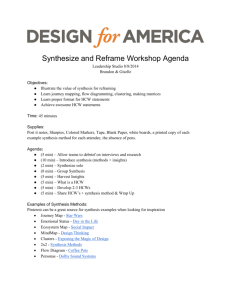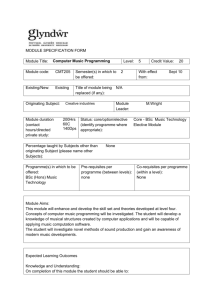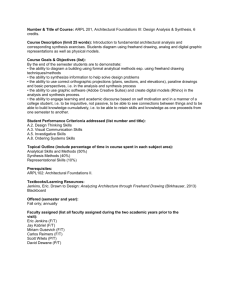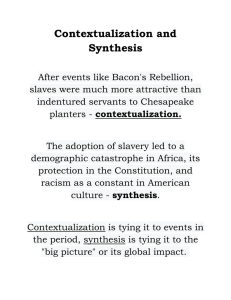T218 Sound Synthesis
advertisement
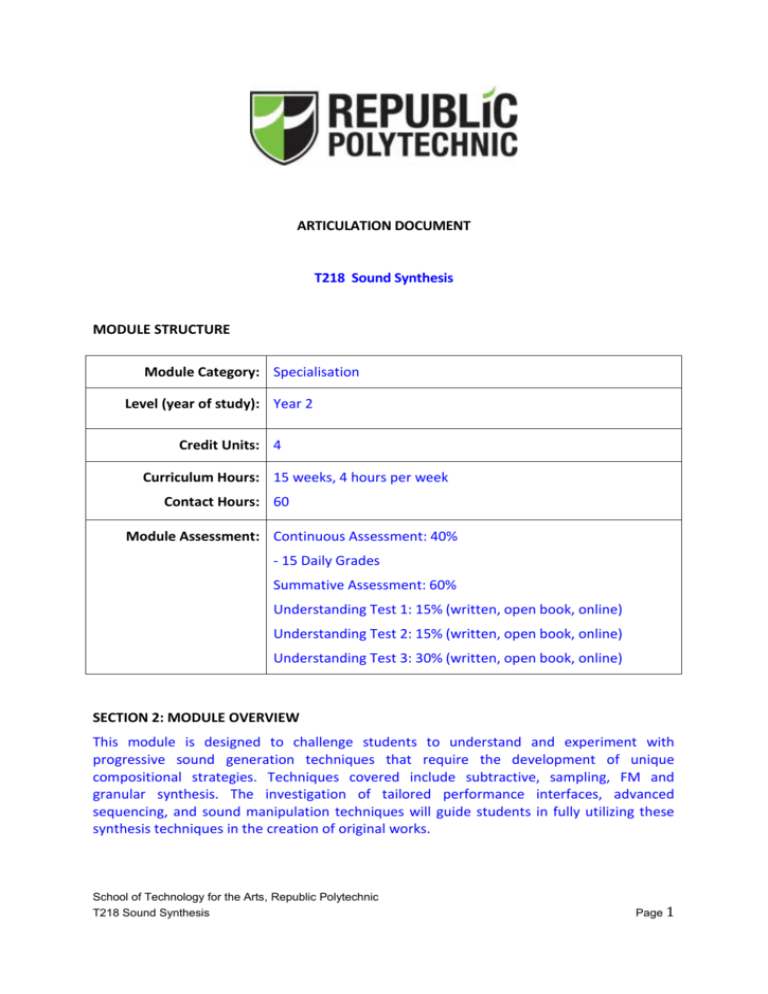
ARTICULATION DOCUMENT T218 Sound Synthesis MODULE STRUCTURE Module Category: Specialisation Level (year of study): Year 2 Credit Units: 4 Curriculum Hours: 15 weeks, 4 hours per week Contact Hours: 60 Module Assessment: Continuous Assessment: 40% - 15 Daily Grades Summative Assessment: 60% Understanding Test 1: 15% (written, open book, online) Understanding Test 2: 15% (written, open book, online) Understanding Test 3: 30% (written, open book, online) SECTION 2: MODULE OVERVIEW This module is designed to challenge students to understand and experiment with progressive sound generation techniques that require the development of unique compositional strategies. Techniques covered include subtractive, sampling, FM and granular synthesis. The investigation of tailored performance interfaces, advanced sequencing, and sound manipulation techniques will guide students in fully utilizing these synthesis techniques in the creation of original works. School of Technology for the Arts, Republic Polytechnic T218 Sound Synthesis Page 1 Modules Aims The module aims to teach both practical and theoretical principles of various sound generating techniques and students learn to PCDF: 1) Apply historical and contextual knowledge of sound synthesis in production practices, including the evolution and development of standards used in music technology. 2) Use both analog and digital sound synthesis tools, for music production and sound effects 3) Work in teams and individually to develop a sonic arts portfolio 4) Use critical listening and sound perception principles to influence own work Module Coverage Lessons take place in an audio lab using both hardware and software synthesizers. Ideally students taking this module should have previously completed T214 (Sound Design). 1) Compare and contrast developments in technology and creative sound synthesis in the performance and music production industry 2) Review works from a range of artists in music genres that use analog and/or digital sound synthesis 3) Discuss and compare synthesis techniques, their processes and acoustics results 4) Use analogue tape/sound manipulation techniques modelled with digital technology for creative and engineering applications in a studio 5) Be aware of the prevalent standards used for the communication between devices (control voltage/gate, MIDI, Open Sound Control) in a synthesis environment 6) Employ modular synthesis techniques to manipulate (patch) signal flow for experimental sound design 7) Distinguish between standards, alternative control surfaces and input devices, and their influence on performance 8) Apply critical listening when synthesizing sounds for production purposes 9) Illustrate the underlying architecture of electronic synthesizers (i.e. modules, components, connectivity), through circuit diagrams 10) Use a range of synthesis techniques (including frequency modulation, amplitude modulation, subtractive synthesis, wavetable and granular synthesis, and frequency modulation) in creating original sonic works School of Technology for the Arts, Republic Polytechnic T218 Sound Synthesis Page 2 MODULE OUTCOMES AND LEARNING OUTCOMES Allocated time per day Module Coverage Discussions in Study Cluster Compare and contrast developments in technology and creative sound synthesis in the performance and music production industry Distinguish between standards, alternative control surfaces and input devices, and their influence on performance Resource gathering and team work Skills acquisition and practice 2 2 0 2 2 2 2 6 8 4 8 8 Review works from a range of artists in music genres that use analog and/or digital sound synthesis Be aware of the prevalent standards used for the communication between devices (control voltage/gate, MIDI, Open Sound Control) in a synthesis environment Employ modular synthesis techniques to manipulate (patch) signal flow for experimental sound design Illustrate the underlying architecture of electronic synthesizers (i.e. modules, components, connectivity), through circuit diagrams Use analogue tape/sound manipulation techniques modelled with digital technology for creative School of Technology for the Arts, Republic Polytechnic T218 Sound Synthesis Page 3 and engineering applications in a studio Use a range of synthesis techniques (including frequency modulation, amplitude modulation, subtractive synthesis, wavetable and granular synthesis, and frequency modulation) in creating original sonic works Apply critical listening when synthesizing sounds for production purposes 2 6 6 12 24 24 Discuss and compare synthesis techniques, their processes and acoustics results Total = 15 Problems = 60 hours TEACHING AND LEARNING This module equips students who wish to pursue a career in experimental sound design such as creating new sounds for music composition via various sound synthesis technique. The module emphasises on hands on practical approach to learn a variety of sound synthesis techniques. Students are encouraged to acquire knowledge of various sound synthesis techniques with the use of both hardware and software. The module is predominantly delivered via a problem based learning style curriculum. However, up to 15% of the module uses a technical hands-on tutorials style curriculum. The module is predominantly taught in a professional music studio. LEARNING RESOURCES Hardware synthesizer such as Doepfer, MiniMoog, Access Virus T1. Software synthesizer such as Native Instrument Komplete instruments and Ableton Live instruments, Propellerheads Reason instruments School of Technology for the Arts, Republic Polytechnic T218 Sound Synthesis Page 4 Books: Power Tools for Synthessizer Programming: The Ultimate Reference for Sound Design Jim Aikin ML74AIK2004 Music, Cognition, and Computerized Sound: An Introduction to Psychoacoustics Edited by Perry R. Cook ML3805MUS2001 Sonic Graphics / Seeing Sound Matt Woolman ML85WOO2002 MIDI Power! Guerin MT723GUE2002 The MIDI Manual David Miles Huber School of Technology for the Arts, Republic Polytechnic T218 Sound Synthesis Page 5


